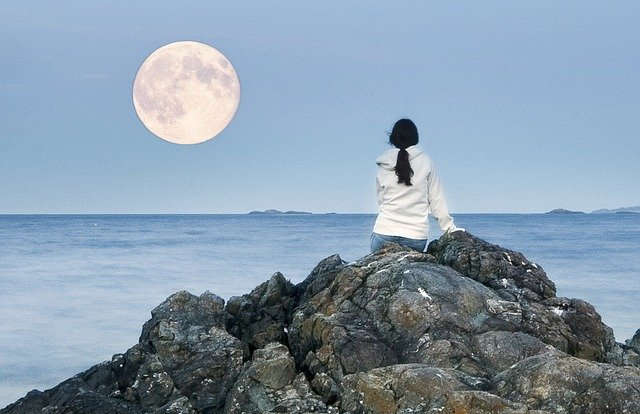In this video and article, you’re going to learn how to perform a moon gazing meditation technique in the Trataka (pr. trah’-tah-kah) tradition.
Trataka, also known as Tratak (pr. trah’-tahk), was a pillar of Hatha Yoga before postures and breathing exercises began to dominate that system. Trataka means fixed gazing.
When doing Trataka, the object you gaze upon can be just about anything: A candle flame, a camp fire or a picture of your grandma. In this meditation, you are gazing at the moon.
You can watch and listen to the video.
There are also instructions below the video. It’s basically a transcript.
Feel free to click the play button and then scroll along with my voice.
Why Stare at the Moon?
There’s something about the changing cycles of the moon that makes this moon gazing practice special. They remind the psyche about the cycles of life.
Ultimately, all experiences of phenomena can be broken down to vibration and cycles. All matter is ultimately a collection of tiny vibrations of light.
The moon itself is a powerful meditation object because of its influence on the subtle psychic energy and dream functions. People who are very sensitive tend to be quick to notice this.
If you’re not into all that woo woo stuff… well, forget I just said that. It doesn’t matter.
When Can You Practice Moon Gazing?
You can practice this technique as a full moon meditation or nightly, whenever the moon is available.
You can also snap a picture of the moon so that you have something to gaze upon when the moon is unavailable.
If gazing at the photo, you can darken the room just enough so that your focus is entirely on the photo.
How to Do the Moon Gazing Meditation

There are two things to remember during this moon meditation. You want to breathe calmly through the nose. You also want to relax into the whole experience, allowing all tension to soften as you notice it.
Go outside to a place where you can easily see the moon.
Gaze at the moon without blinking for as long as you can. Imagine the moon as an experience happening inside of you. Ultimately, that is exactly what it is anyway.
Allow the gaze to soften so that you increase your ability to “take in” the moon. Relax into your experience of the moon. Become one with the moon.
I know. That sounds cliche and like a bunch of hooey. As you become more intimate with the experience of the moon, you are, in a sense, falling in love with the moon. Lovers merge. They become one even though they have separate personalities. This is what concentration meditation is all about.
The eyes may start to water. If so, let a few tears come out, then close your eyes. If they don’t water, close your eyes once you feel like it’s a strain keeping them open.
You may notice an imprint of the moon when your eyes are closed. It may be different colors than the actual moon. That’s OK. You should experience some type of impression from your gazing.
This is your object of focus now.
With eyes still closed, point your eyes up toward the point between the eyebrows. You may feel a “sweet spot” that feels just right. Keep watching that impression of the moon.
The impression may start to disappear after a few moments. Open your eyes and gaze at the moon again. You have just completed one cycle.
If you don’t see the impression, that’s OK. Focus on your breathing during that time. When your eyes have recuperated, open them and repeat the whole cycle starting with the gazing at the moon.
Alternatively, some teachers suggest that you actually try to recreate the image of the moon when your eyes are closed. Of course, you also have the impression to work with too.
Either way, the image of the moon will reconstruct itself more completely in your mind’s eye as time goes on.
The inner impression of the moon is, in a sense, just as real as the moon that you are gazing at with eyes open. Both are experiences happening inside of you. With moon gazing practice, you may become more aware of this reality over time.
If you’re a beginner, you might be able to keep your eyes open without blinking for 15 seconds or so. After a while, you may increase this as stamina allows. Some people will moon gaze for ten or fifteen minutes without blinking.
The moon gazing meditation is a concentration meditation. If the mind wanders off, you go right back to the moon or its inner imprint. However, you can turn this into a mindfulness meditation as well.
When thoughts come up, take note of them and allow them to be what they are. Be the impartial observer. Focus your attention to the thinker rather than the thought. Then, gently go back to the moon. Click here for more elaborate mindfulness instructions.
Moon Gazing Health Benefits
We won’t get into the scientific reality here, but here are some of the reported benefits of moon gazing meditation. The benefits of Trataka include but are not limited to the following.
1. Relief from insomnia
2. Remarkable concentration abilities
3. Correction of eye problems such as myopia, farsightedness and the early stages of cataracts (I haven’t verified this, but it’s a common claim)
4. Development of the third eye and intuitive abilities
5. Deep relaxation and many of the other benefits you receive from meditation
Related: Eye Gazing Meditation for Partners
Share Your Insights or Questions
What are your experiences with Trataka and moon gazing meditation? Share them in a comment below.
Is anything unclear/wrong/etc? Ask a question or chime in with some input below.
Tom Von Deck is a meditation trainer, speaker, and speaker. Tom specializes in making meditation much much easier for busy and non-busy people from all backgrounds and paths. He is the Mackdaddy of The Deeper Meditation Video Zone and DeeperMeditation.net.




5 comments
Sue
I did a meditation on the moon just before the new moon. I gazed at the point where it would be if it was visible at that time. My eyes streamed and I felt as if my body was rocking forwards and then back. It was at this point I felt a distinct pulling at my solar plexus, as it feels when the chakra is being opened by a practitioner. It was extremely interesting, and I wondered if anyone else had ever experienced that. Kindest regards, Suze
Robyn
Beautiful post ❤️🙏